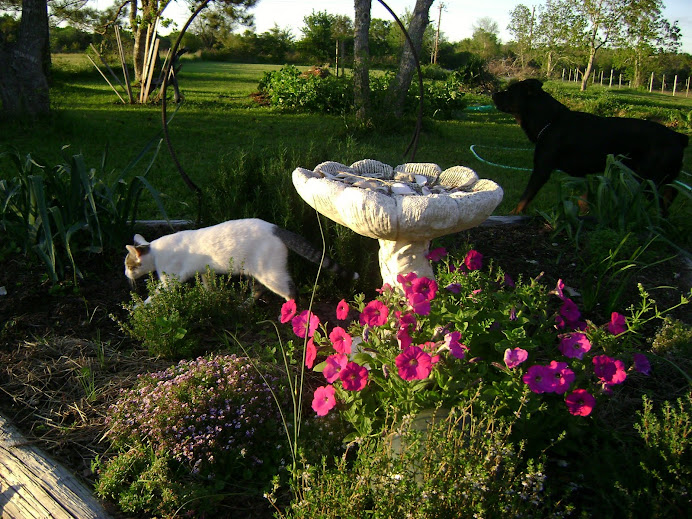Bug season is here and organic gardeners know the importance of monitoring the insect activity closely. We have already discovered our first batch of stink bug nymphs on a blackberry cluster.
The stink bug nymphs, which is the immature stage of this garden pest appear almost ant like. They are larger than an ant with bright reddish orange bodies and black legs.
This is not the clearest picture of the nymphs, sorry! I got over zealous with my close up I think. Although there are a few different types of stink bugs, the one most common and that does the most damage in the southern regions are the leaf footed. They virtually suck the juices right out of your juicy fruits right as they begin to ripen.
We use Diatomaceous Earth for a whole host of natural and safe preventive methods as well as spot on treatments. I've recently written an article for Natural Family Today about precautions when using DE and exactly what the stuff is. The most important thing to know about DE is that it is dangerous for your beneficial insects if not used properly. So please read the article to see what it is all about before using it.
So I call this sort of our Shake-n-Bake method, although we are really not doing any baking here. Basically you take a plastic bag or even a paper bag would work for this. I have to say that I like the plastic bag because it is clear and I can see what I'm doing better. Place a little bit of Diatomaceous Earth in the bag, close it and shake it. The DE will stick to the bag in the same way flour would. Then slip the bag over the branch with the cluster of nymphs on it and close the open end with your fingers. Gently tap the branch around into the bag.
As you can see in this photo, the DE was only applied to the affected area. DE contains no harmful chemicals or poisons and is a completely natural and safe substance. Although it was a possibility with this experiment of drying the tender berries out with the DE, I've monitored it on a daily basis. So far the fruit has not dried in any form or fashion.. Most of the DE after a couple of days has vanished with the dew.
It appears as though all of the nymphs are trapped in the bag. I would say there were easily a dozen of the rascals. I know we won't have to worry about them turning into the adult leaf footed stink bugs to damage our other fruits.
It appears as though all of the nymphs are trapped in the bag. I would say there were easily a dozen of the rascals. I know we won't have to worry about them turning into the adult leaf footed stink bugs to damage our other fruits.
CAUTIONS:
- NEVER use pool filter grade or any Diatomaceous Earth other than those labeled “food grade”. Pool filter and some DE sold as insecticides contains additives that are harmful to you and your animals.
- Because DE acts as a drying agent, avoid contact with eyes and lungs.
- Do NOT use heavily on carpets to avoid vacuum problems.
- Use wisely around pollinating and beneficial insects
Happy Gardening!
Pammy























.jpg)



















I've been seeing lots of these dreaded pests in my garden this week. I had not heard of the DE method of control. It's certainly worth a try.
ReplyDeleteHi Dorothy! It is not a full proof method by all means, but it really puts a dent in some of it. I'm afraid we're in for a very buggie season this year so I've been pulling all the tricks I have out of my garden hat ;) xox
ReplyDeleteUnfortunately, we are going to have a lot of the brown marmorated stink bugs in our gardens, Pammy and they like the lemon verbena herb a lot! Have to put some DE on them. Thanks for sharing. xxoo Nancy
ReplyDeleteNancy, I had no clue they were attracted to Lemon Verbena! They are breaking out here in full force this spring. I've been finding clusters in some of the tomato plants I hadn't protected early enough. Let the battle begin! ;/
DeleteI never knew what these bugs were. I noticed a bunch of them on my basil today! Thanks.
ReplyDeleteActually I don't think I have the same bugs on my plant now that I look again. Does anyone know what the thin orange bugs are? They look like an ant with a bright orange body.
ReplyDeleteHi Lori, Well there are a couple of other nymphs that look like that. The Assassin bug looks like it too..more slender...perhaps this is who you have?
DeleteDE is great stuff int he garden. We have problems with the cabbage worm on broccoli. We did use it in the dust bath for the chicken and we never had a mite problem, not once! We don't have chickens anymore but we do have a garden. I'm hoping, if we are careful not to get it near any flowers in bloom, the bees should be safe.
ReplyDelete- Sheryl - sherylsgarden.com